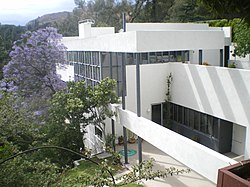Lovell House
Lovell House | |
 | |
| Location | 4616 Dundee Dr, Los Angeles, CA 90027 |
|---|---|
| Coordinates | 34°7′5.4″N 118°17′16″W / 34.118167°N 118.28778°W |
| Area | 2.5 acres (1.0 ha) |
| Built | 1928 |
| Architect | Richard Neutra |
| Architectural style | International style |
| NRHP reference No. | 71000147[1] |
| LAHCM No. | 123 |
| Significant dates | |
| Added to NRHP | October 14, 1971 |
| Designated LAHCM | March 20, 1974 |

The Lovell House or Lovell Health House is an International style modernist residence designed and built by Richard Neutra between 1927 and 1929. The home, located at 4616 Dundee Drive in Los Angeles, California, was built for the physician and naturopath Philip Lovell. It is considered a major monument in architectural history, and was a turning point in Neutra's career.[2]
It is often described as the first steel frame house in the United States, and also an early example of the use of gunite (sprayed-on concrete). Neutra was familiar with steel construction due to his earlier work with the Chicago firm Holabird & Roche. Neutra served as the contractor for the project in order to manage the cost and quality.
Design
The house aesthetically follows many of the principles of the International Style. It was included in the 1932 exhibit at the Museum of Modern Art in New York that retrospectively defined the style. In essence it reflects Neutra's interest in industrial production, and this is most evident in the repetitive use of factory-made window assemblies. In fact, Neutra's apprentice Harwell Hamilton Harris suggested that Neutra was drawn to America because of Henry Ford.[3]
The interior reflects Neutra's interest in Cubism, transparency, and hygiene. The "minimal" detailing shows the influence of Irving Gill. In another nod to industrial production, Neutra installed two Ford Model-A headlights in the main stairwell. (The headlights were provided by Neutra apprentice Gregory Ain.)[4] The Historic American Buildings Survey described the Lovell House as "a prime example of residential architecture where technology creates the environment."[5]
Philip Lovell was enchanted with the house and praised his architect publicly. Lovell had previously commissioned architect Rudolf Schindler to build the landmark Lovell Beach House in 1926. Neutra and Schindler were contemporaries in Europe and the Neutras lived with the Schindlers (Schindler House) when they first settled in Los Angeles in 1925. Dr. Lovell chose Neutra instead of Schindler to build his Los Angeles home while they were living under the same roof. Neutra was known for his relationships with his clients—he thought of himself as a therapist and the client his patient. He spent time getting to know his clients and analyzed their needs.[6]
The Lovell House was added to the list of Registered Historic Places in Los Angeles in 1971.
In film productions
The house was used in the 1997 film L.A. Confidential as the home of Pierce Morehouse Patchett, played by David Strathairn. It was also depicted in the film Beginners (Mike Mills, 2010) as the home of Oliver (Ewan McGregor) and his father Hal (Christopher Plummer).
See also
Notes
- ^ "National Register Information System". National Register of Historic Places. National Park Service. July 9, 2010.
- ^ Hines, Thomas (1982). Richard Neutra and the Search for Modern Architecture. Oxford University Press. ISBN 0-19-503028-1.
- ^ Jackson, Neil (1996). The Modern Steel House. Taylor & Francis. p. 7. ISBN 0-419-21720-7.
- ^ Denzer, Anthony (2008). Gregory Ain: The Modern Home as Social Commentary. Rizzoli Publications. ISBN 0-8478-3062-4.
- ^ Giebner, Robert C. (July 24, 1969). "Lovell (Health) House" (PDF). Historic American Buildings Survey. Washington, D.C.: Library of Congress. p. 1. Retrieved March 10, 2014.
- ^ Lavin, Sylvia (2004). Form Follows Libido: Architecture and Richard Neutra in a Psychoanalytic Culture. Cambridge, Mass.: MIT Press. ISBN 978-0-262-62213-4.
External links
- Great buildings online
- Historic American Buildings Survey (HABS) No. CA-1936, "Lovell (Health) House, 4616 Dundee Drive, Los Angeles, Los Angeles County, CA", 9 measured drawings, 10 data pages



